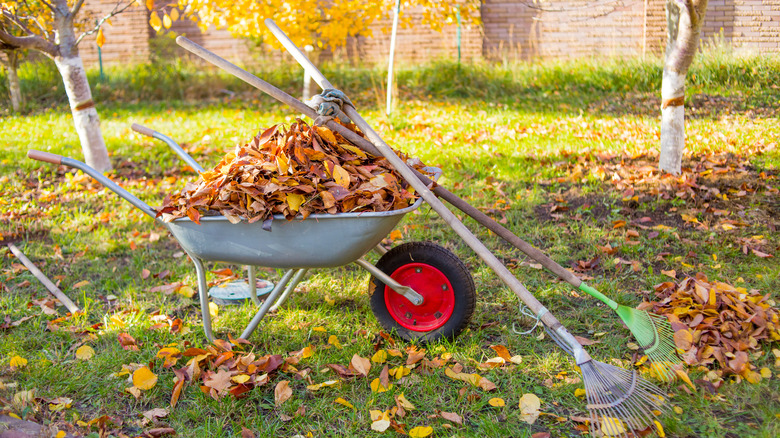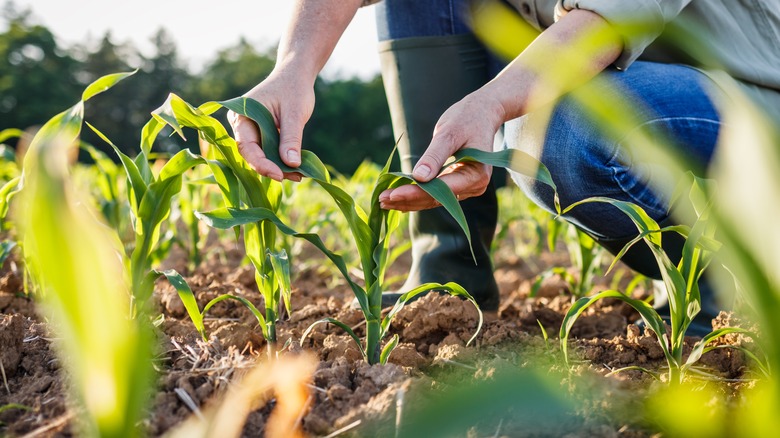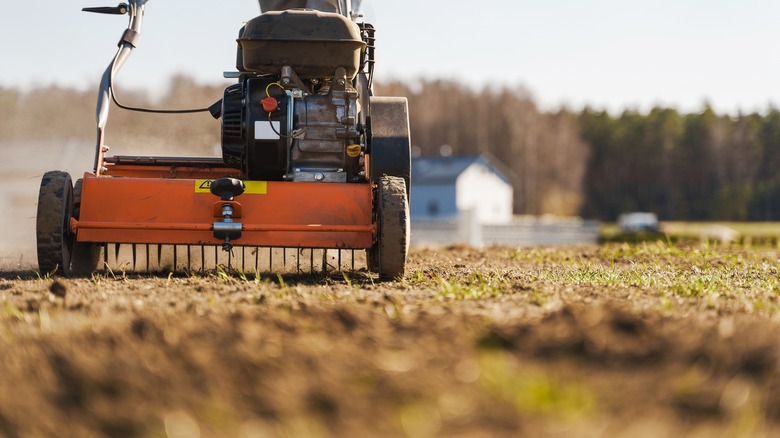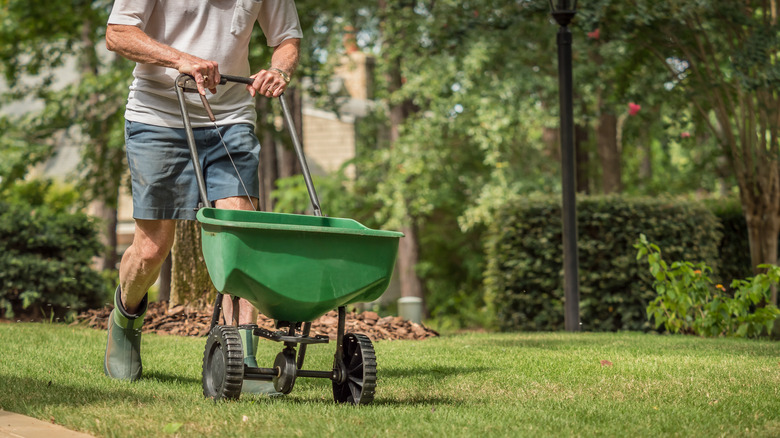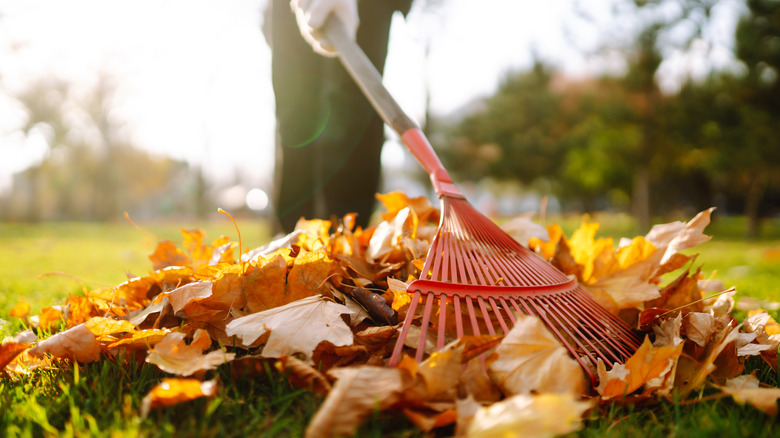5 Tips For Caring For Your Lawn This Fall
Fall is one of the most naturally picturesque seasons, with shades of orange, yellow, red, and purple taking over the bright summer green, crops starting to ripen, and flowers reaching the end of their blooming cycle. It's also an ideal time to get your yard in order before winter. Whether you have a simple, neat lawn, full flower beds, or a vegetable garden, fall is an incredibly lucrative season for planting, cleaning up, and preparation.
As GardenTech notes, fall has the unique benefit of having cold air but warm soil temperatures, as well as fewer insects, garden pests, weeds, mold, and unpredictable weather, making planting much more straightforward and viable. It's also your last chance to get your landscape affairs for the spring. In the interim, there's still maintenance and upkeep to consider for a healthy yard. Keep reading to learn how to care for your yard in the fall properly.
1. Plant seeds for the next season
While there are plenty of lucrative fall crops that you can plant in the summer, obvious favorites like corn and pumpkins, there are also plenty of spring crops that can benefit from being sown in the fall. While sowing seeds in the fall may seem like a bad idea with the upcoming winter, it's incredibly beneficial.
According to Rural Sprout, not only will the warm soil and cool air help the seeds germinate quicker, but the seeds that survive the winter frost will be incredibly hardy for years to come. It will also encourage earlier blooms and harvests. You should also consider planting spring flower bulbs at this time, too. Some great seeds to get in the ground this fall include kale, lettuce, onions, garlic, shallots, asparagus, turnips, carrots, spinach, and beans. Some good herbs to plant include lavender, rosemary, and sage. Some flowers to get planted in preparation for spring are black-eyed Susans, coneflowers, cosmos, and poppies, via Empress of Dirt.
2. Fertilize the soil
Another reason that fall is such a lucrative time to care for your lawn is that the soil and grass are under a lot less stress than in the summer due to the cooler conditions, notes The Davey Tree Expert Company. If your grass was looking a little dry or weak in the summer, odds are it'll start to spring back to life in the fall. This also makes it a great time to fertilize your lawn for an extra boost.
A few factors contribute to excellent fall fertilization conditions — stronger grass roots, more stamina and durability, and morning dew for extra absorption. Plus, fewer insects and garden critters are crawling around and disrupting the lawn. The fertilizer you should get depends on your specific environment, type of grass, and needs, so consult a local landscape company or garden center for advice. Find the estimated first frost date, and plan your fertilization for roughly two to three weeks in advance — make sure there aren't any incoming rainstorms. In either the morning or just before the evening, mow your yard for what will likely be the last time of the season. Then, spread your fertilizer per the package instructions.
3. Aerate the ground
Grass, like all plants, needs oxygen to survive and thrive. While you may think your lawn gets plenty of oxygen, the roots underneath also need this essential gas. This can be done through aeration, which essentially involves creating multiple small holes in the dirt that allows oxygen, as well as water and other nutrients, to get deep into the grass's root system and prevents compacted soil, per Lawn Love.
If you have Kentucky bluegrass or another type of grass for colder climates, fall is the perfect time for aeration. The grass is cool without being too hard, meaning weeds and bugs won't interfere with the process. You should aerate your lawn before any seeding or fertilization, though. The easiest way to aerate your lawn is with a push machine similar to a mower, which has a rotating wheel of tiny spikes that evenly aerates the grass. These can be expensive, but you can usually find them for rent. There are also hand/manual aerators that look somewhat like pitchforks that are much cheaper but more laborious. A fork can work in a pinch, but it isn't ideal.
4. Reseed and overseed
Another lawn maintenance task best done in the fall, especially in cooler regions, is seeding your yard, whether reseeding bald patches or overseeding thin grass. As with all other tasks, this activity is ideal in the fall because of the cool air and warm soil combination, and the lack of weeds, per Pennington. This should be done roughly six weeks before the first frost but after aeration.
Begin by choosing your seed, which should match what's currently growing in your yard. Clean up the clippings, and then run a rake over your shorn lawn to remove any other debris and break up the soil, which will help the seeds germinate better. Then, using a seed spreader, simply spread the seed around your lawn. Keep your grass watered and well maintained; after the winter frosts, your grass should grow back stronger and healthier, making your outdoors colorful and well-maintained.
5. Rake your leaves
Finally, it would help if you regularly raked your yard in the fall to remove dead leaves and other debris. This is one of the most classic fall chores, and for a good reason. While it does help your yard look tidy, it should also be done for practical reasons. As Super Sod points out, unraked leaves will begin to rot, developing and spreading fungus and other harmful diseases. They can also suffocate your lawn.
Leaves can also be a safety hazard, as they get slimy after rainfall and become very easy to slip on in both your yard and sidewalks. The best rake for your lawn is a long metal one, which gets up the leaves and helps remove thatch. You can also use a leaf blower, but pick up the leaves instead of leaving them on the street. Either dispose of them in the city-approved lawn bags or use them in compost.
